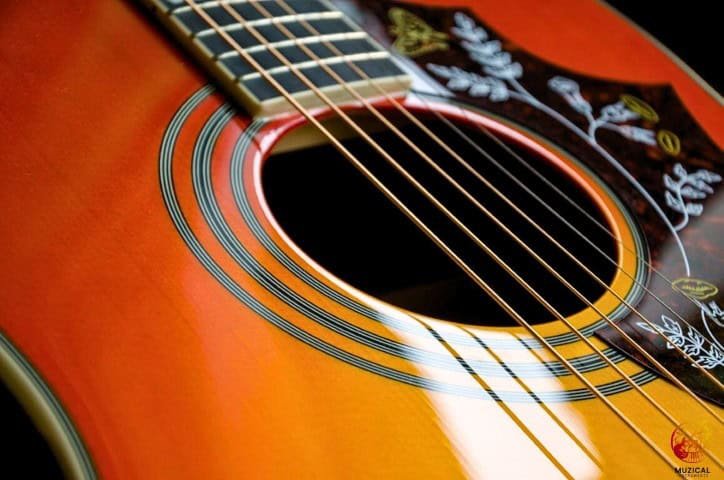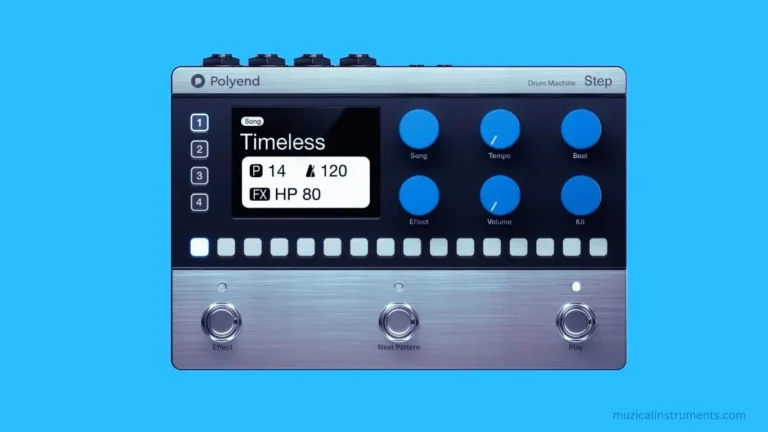Is a Guitar Chord Presser Worth it?
Starting to learn guitar can be exciting, but also frustrating when things don’t go as expected your fingers hurt, chords sound wrong, and progress feels slow.
It’s easy to feel stuck or want to give up, especially when your hands feel stiff and playing chords seems too hard.
That’s where a tool called a “guitar chord presser” can help. Instead of pressing strings with your fingers, you just press buttons to play chords.
It’s not a forever fix, but it makes starting way easier. Once you get the hang of it, you can slowly move to playing chords the regular way.
So, is it a smart way to begin or something that might hold you back later?
Let’s find out if this gadget is the right boost to start your guitar journey.
What Is a Guitar Chord Presser and Who Is It For?
What a chord presser actually does
A guitar chord presser (also called a chord assist device or fretboard chord helper) is a tool that helps you play chords on your acoustic or classical guitar. It attaches to the neck of your guitar, and instead of using your fingers to press the strings, you press color-coded buttons or levers on the device. These buttons push down the right strings to form common chords like G, C, D, Em, and A.

Think of a guitar chords presser like training wheels for your instrument. Instead of trying to learn how to balance and ride all at once, you can focus on the rhythm and strumming, while the tool helps with forming the chords.
Popular models, like ChordBuddy or the E-Z Chord System, are made for regular acoustic guitars. They often come with visual guides, lessons, and songbooks to help you get started.
Designed for
A chord presser isn’t for everyone but for the right player, it can be a game-changer.
Beginners Struggling With Finger Pressure or Chord Clarity
New players often struggle with finger pressure and buzzing strings. A chord presser helps skip the frustration and gets you playing songs faster.
Players With Arthritis or Limited Hand Mobility
If hand pain or mobility issues make pressing chords tough, this tool allows you to enjoy playing without strain.
Casual Players Who Just Want to Strum and Sing
Not everyone aims to master solos, some just want to play simple songs. A chord presser makes that possible with less effort.
Used in Education and Learning Kits
Used in schools and beginner kits, chord pressers help students and special needs learners build confidence, rhythm, and musical interest early on.
How a Guitar Chord Presser Can Support Learning
A guitar chord presser offers a helpful bridge across early frustration, making the learning curve feel less steep and more encouraging.
Eases Initial Frustration
One of the hardest parts of learning guitar is making the right chord shapes. For many beginners, this means sore fingers, awkward hand positions, and buzzing strings. A chord presser makes it easier by pressing the strings for you, so you can play real songs right away instead of waiting for weeks. This helps beginners stay excited and keep practicing in the early stages of learning.
Builds Confidence Through Early Success
Playing a few simple chords from your favorite songs can make you feel really proud. When you can strum along with the music right away, it helps you stay motivated and keep going. A chord presser can give you that “I can do this” feeling, which makes you want to keep playing and learning more on the guitar.
Improves Rhythm and Strumming Skills
One great benefit is that it helps you focus on strumming and timing, without worrying about finger placement. This means you can start practicing rhythm, which is often the hardest part for beginners, right away. Since good rhythm is key to playing guitar well, this focused practice can really help you later on.
A Stepping Stone for Limited Mobility
For people with arthritis, wrist pain, shaking hands, or other problems with movement, a chord presser can make the difference between playing music and giving up. It gives them a way to start playing, offering both comfort and a sense of joy in making music.
The Real Drawbacks of Using a Guitar Chord Presser
A guitar presser can make learning easier in the beginning, but it’s not without its downsides. In fact, relying on one for too long can actually hold back your growth as a guitarist.
Stunts Real Finger Development
One important part of learning guitar is building finger strength, control, and the right finger placement. Chord pressers skip this step. Instead of learning how to press the strings correctly, your fingers don’t really have to work, so you’re not building the skills needed for playing guitar in the long run.
Restricts Chord Options and Playing Styles
Most chord presser systems only help you play a few basic chords, like C, G, D, E, A, and Em. These are good for simple songs, but they don’t help with other chords like barre chords, jazz chords, or power chords, or for playing lead guitar. So, if you want to become a better and more versatile player, you will quickly outgrow the device.
Builds False Muscle Memory
Since your fingers aren’t forming the chords, your muscle memory gets used to pressing buttons instead of pressing the strings. This can make it harder later on, because your hands will have to unlearn old habits and start fresh when you try to play without the device.
Delays Real Progress if Overused
The biggest problem? Relying on it too much. If you use a chord presser for too long, it can make you feel like you’re getting better, even though you’re not really learning the skills you need to move past the beginner level. It becomes a comfort zone that slows down your progress without you noticing.
Better Long-Term Alternatives for Learning Guitar
A guitar chord presser might get you playing quicker, but if your goal is to grow as a musician, there are more effective ways to build real skill that lasts. These alternatives not only improve your technique, but they set you up for freedom across styles, genres, and playing levels.
Master the Essential Open Chords
Start by learning the classic open chords: G, C, D, E, A the backbone of countless songs. These chords form the foundation of rhythm guitar and will train your fingers to build strength, accuracy, and coordination. Yes, they can be tough at first but the payoff is huge.
Practice Finger Strength and Coordination
If your fingers feel weak or awkward, you’re not alone. That’s just part of learning. You can improve by practicing spider drills, taking your time with slow chord changes, and doing finger stretches. These exercises will make your hands stronger and help you get better at pressing the strings cleanly and changing chords smoothly.
Use Modern Learning Tools
There’s never been a better time to learn guitar. Websites like JustinGuitar, Fender Play, and Yousician have easy lessons that teach you everything from basic chords to full songs. You can also use YouTube tutorials, mobile chord trainers, and fun guitar apps to make learning more exciting and easy to follow anytime you want.
Get Guided Feedback Early
One of the best investments you can make, Real feedback. Whether it’s from a private teacher, local music school, or small group class, having someone correct your hand position or strumming technique early on helps avoid forming bad habits. Personalized instruction keeps you focused and progressing faster.
Who Should Use a Chord Presser and And Who Probably Shouldn’t
A guitar chord presser isn’t a one-size-fits-all tool. For some, it can be the perfect on-ramp to making music. For others, it may become more of a roadblock than a bridge. If you’re wondering whether it fits your goals, here’s a no-nonsense breakdown.
Great For:
Total Beginners Starting from Scratch
If you’ve never played guitar before and find chords hard or painful, a chord presser like ChordBuddy can help you start right away. It makes learning easier, so you can quickly play and sing your favorite songs.
Casual Players Who Just Want to Jam
Not everyone wants to learn theory, scales, or solos. If you just want to play a few songs at family events or relax after work, a chord presser is an easy way to start without needing hours of practice.
Players with Physical Challenges
For people with arthritis, stiff joints, hand tremors, or old injuries, pressing chords can be really hard. Chord pressers help them play music without needing strong or flexible fingers, making it easier for everyone to join in.
Not Ideal For:
Intermediate and Advanced Players
If you already know some chords or have stronger fingers, a chord presser might feel limiting. It stops you from exploring more on the fretboard and keeps you with easy chords.
Songwriters, Improvisers, and Lead Guitarists
Creativity needs freedom. Whether you’re making your own chords, playing jazz, or doing lead guitar, you need full control of your fretboard. A chord presser can’t give you that.
Anyone Focused on Long-Term Growth
Want to be a skilled guitarist? Whether you want to join a band, play shows, or try more advanced music, a chord presser won’t take you there. It’s good to start with, but you still need to learn real skills, muscle memory, and music theory.
Final Thought:
Use a chord presser if you need a leg up, but don’t mistake it for the full path. Like training wheels, it’s best used briefly and with purpose, then set aside when you’re ready to ride on your own.
Popular Brands of Guitar Chord Pressers
Not all guitar chord pressers are the same. Some are made for beginners, while others give more flexibility or use different ways to simplify chords. Here’s a look at the most popular ones today:
ChordBuddy
ChordBuddy is one of the most well-known names in this space. It’s been shown on Shark Tank and is mostly aimed at beginners. It uses color-coded buttons that match lesson books and video guides.
- Best for: Beginners, kids, and classrooms.
- Bonus: It often comes with lessons and starter kits.
E-Z Chord
The E-Z Chord device is one of the earliest chord pressers on the market. It attaches to the fretboard using a clamp and allows for basic major and minor open chord changes. While the design is a bit dated, it’s still found in beginner circles and music classrooms.
- Best for: Players focused only on the simplest chord progressions.
- Limit: Less ergonomic and not as beginner friendly as newer models.
Eurostring ChordMaster
The Eurostring ChordMaster is less common in the U.S. and offers more chord options than regular button pressers. It’s a bit more advanced and is good for players who want more chords without finger strain.
- Best for: Casual players or teachers in Europe who need extra flexibility.
- Note: It may be harder to find depending on where you live.
ChordMate
ChordMate is a newer, smaller option designed for light guitars and easy travel. It’s not very popular yet, but it’s a good choice for players who want a slim alternative to big setups.
- Best for: Lightweight travel guitars, experimenters, or those trying out different tools.
- Caution: It may not work well with all guitar sizes or string spacings.
When picking a chord presser, make sure it works with your guitar type (acoustic or electric) and what you want to play. Most are made for standard acoustic guitars and only support basic chords, so check if it’s right for you before buying.
Comparison: Which Chord Presser Is Right for You?
Finding the right chord presser depends on your guitar type, learning goals, and how much you plan to rely on it. Here’s a side-by-side comparison to help you choose the one that fits your style:
Chord Assist Devices: Which One Fits Your Needs?
| Brand | Strengths | Weaknesses | Best For |
|---|---|---|---|
| ChordBuddy |
|
|
|
| E-Z Chord |
|
|
|
| Eurostring ChordMaster |
|
|
|
| ChordMate |
|
|
|
How to Install a Chord Presser (Quick Setup Guide)
Installing a chord presser for guitar is usually straightforward. Here’s a step-by-step walkthrough so you’re not fighting buzz, string mutes, or misalignment.
Step-by-Step Setup (Using ChordBuddy as an Example)
- Place the Device Just Above the Nut
Slide the ChordBuddy onto the neck of your guitar, just above the nut (the small ridge that holds the strings). Make sure it fits snugly but not too tight.
- Align Each Button Pad with the Correct String and Fret
Each button is mapped to a specific chord (G, C, D, E minor). Take your time lining up the rubber pads so they press cleanly on the correct fret and string. Misalignment = string buzz. - Secure Gently Using the Clamp or Fastener
Use the included mounting tool to secure it to the neck, it should be firm, but never forced. Overtightening can damage your fretboard or mess with tuning. - Test by Pressing Buttons and Strumming
Press each button individually and strum lightly. If the chord rings out clean and clear, you’re golden. If not, you may need to fine-tune the position. - Adjust as Needed
Even a slight shift in position can make a big difference in sound clarity. Realign until all chords sound full and buzz-free.
If you want to create loops or control patterns while pressing chords, the Polyend Step sequencer for guitarists might be the perfect tool to explore.
FAQ
What is the 1/3/5 rule for chords?
The “1-3-5 rule” for chords is a basic principle for constructing major chords, where you use the first, third, and fifth notes of a major scale to create a triad, which is a chord made up of three notes.
What is the 80/20 rule guitar?
This rule, often called the Pareto Principle, indicates that 80% of your outcomes are determined by just 20% of your actions. When applied to guitar practice, it suggests that concentrating on the key elements of playing can lead to substantial progress in less time.
What does 145 mean on guitar?
Using the 1-4-5 rule on guitar is like unlocking a hidden shortcut to music. For example, in the key of C Major, the 1st note is C, the 4th is F, and the 5th is G. This gives you the chords C Major, F Major, and G Major. And just like that, you’ve got your 1-4-5 chord progression!
What is the 135 rule in music?
The 1-3-5 rule in music refers to building triads, where the root note is the foundation, the third note decides if the chord is major or minor, and the fifth note provides strength and balance to the chord’s framework.
What is the 10000 hour rule for guitar?
The 10,000-hour rule suggests that to reach world-class mastery on the guitar, you must dedicate 10,000 hours to focused, deliberate practice. This breaks down to over 3 hours of daily practice, consistently, for a decade.
What is the golden rule of guitar?
The “golden rule” of guitar strumming is to use downstrokes on downbeats (strong beats like 1) and upstrokes on upbeats (in-between beats), ensuring a steady rhythm. While exceptions exist, it’s a solid foundation for beginners.
What is the forbidden chord on guitar?
The “forbidden chord” or “devil’s chord” is the tritone, a dissonant interval of three whole tones (e.g., C to F#), historically avoided for its unstable sound and dubbed “Diabolus in musica.” While once shunned, it’s now common in rock and blues.
Final Verdict: Is a Guitar Chord Presser Worth It?
A guitar chord presser can be a great tool for beginners. It helps you play songs fast without worrying about finger pain or hard chord shapes. It’s also good for people who have trouble moving their hands.
But the truth is, It won’t teach you how to really play guitar.
You won’t learn how to use your fingers, switch chords on your own, or play harder songs. If you use it too long, it can slow you down.
Think of it like training wheels on a bike. It helps you at first, but one day, you’ll need to take it off to ride on your own.
Use it for a little while, but don’t forget to learn real guitar skills too.




